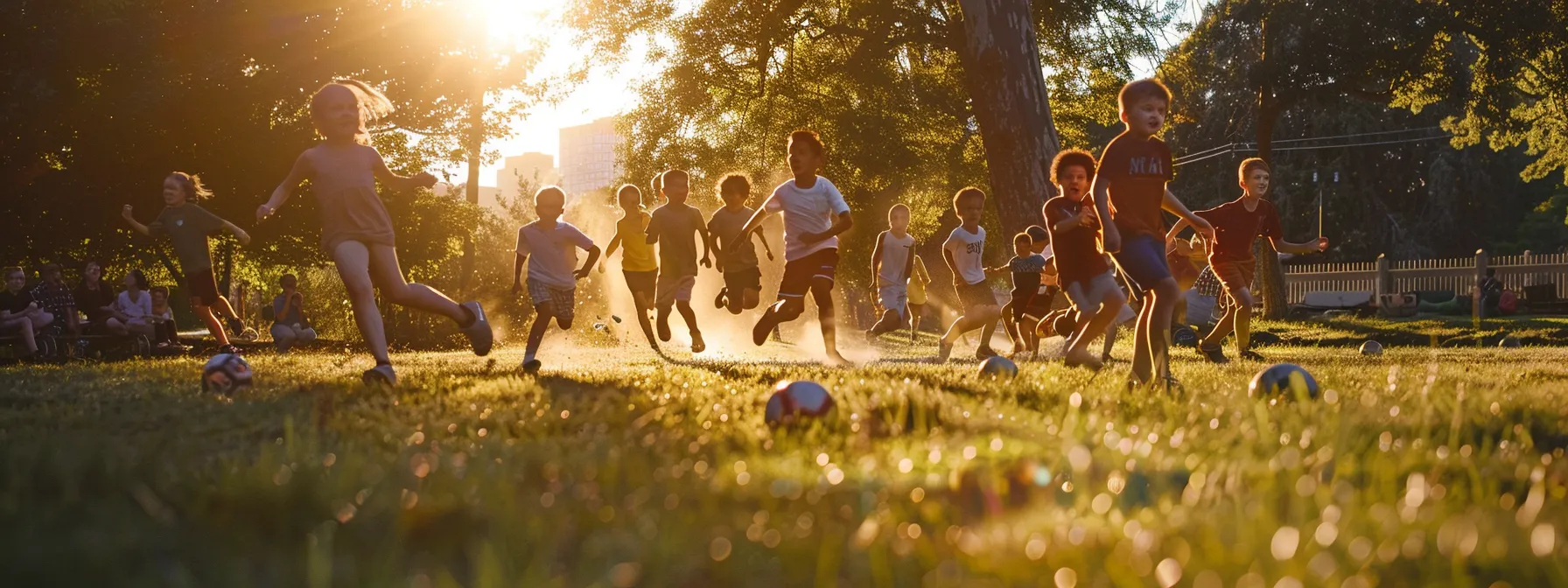Table Of Contents:
- Promoting Healthy Growth: A Guide to Children’s Wellness
- Key Takeaways
- Establishing a Balanced Diet for Growing Children
- Introduce a Variety of Fruits and Vegetables Early On
- Understanding the Importance of Proteins and Carbohydrates
- Limiting Sugar and Processed Foods
- Incorporating Healthy Fats Into Daily Meals
- Staying Hydrated With Water Rather Than Sugary Drinks
- Encouraging Regular Physical Activity
- Setting a Daily Playtime Routine
- Choosing Age-Appropriate Physical Activities
- Limiting Screen Time to Promote More Active Play
- Encouraging Participation in Team Sports
- Making Physical Activity a Family Affair
- Prioritizing Mental and Emotional Well-Being
- Fostering Open Communication About Feelings
- Establishing Routines to Provide Stability
- Teaching Stress-Reduction Techniques Suitable for Children
- Recognizing Signs of Anxiety or Depression in Children
- Creating a Supportive and Positive Home Environment
- Importance of Regular Health Check-Ups
- Keeping Up With Vaccination Schedules
- Monitoring Growth Milestones
- Preventative Care to Avoid Common Illnesses
- Addressing Any Nutritional Deficiencies
- Ensuring Dental Health From an Early Age
- The Role of Adequate Sleep in Child Development
- Establishing a Consistent Bedtime Routine
- Understanding the Sleep Needs of Children by Age
- Creating a Sleep-Conducive Environment
- Addressing Common Sleep Issues Among Children
- Limiting Screen Time Before Bed
- Educational and Social Skills Development
- Encouraging Learning Through Play
- Nurturing Curiosity and Creativity
- Promoting Social Interactions and Teamwork
- Supporting the Development of Empathy and Emotional Intelligence
- Preparing for School Readiness and Beyond
Promoting Healthy Growth: A Guide to Children’s Wellness
Ensuring the well-being of our children is a multifaceted task that hinges on a constellation of factors, from maintaining optimal weight to fostering mental resilience against anxiety and violence. Within the fabrics of family and community, we find the fertile grounds for instilling lifelong habits that propel our youth toward their fullest potential. Establishing a robust foundation for physical health, psychological fortitude, and societal engagement is not merely a personal endeavor, but a collective goal that resonates through every layer of our interactions with the younger generation. Keep reading to delve into the vital strategies for nurturing a wholesome path for children’s wellness and development.
Key Takeaways
- Balanced diet and regular exercise are foundational for children’s wellness
- Diverse physical activities tailored to age ranges enhance developmental growth
- Limiting screen time before bed helps foster healthier sleep patterns
- Encouraging emotional expression and routine builds stability and resilience
- Cultivating curiosity and teamwork in play advances learning and social skills
Establishing a Balanced Diet for Growing Children

Navigating the complexities of nutrition for children, where every meal contributes to their overall growth, can feel like a task on par with navigating a post-op recovery sans the guidance of the American Academy of Pediatrics. My objective here is not only to demystify the foundations of a wholesome diet necessary for the exuberance of youth but also to empower you with knowledge to make informed choices. Introducing a rainbow of fruits and vegetables to your child’s plate early on sets the stage for a lifetime of healthy eating habits. It’s about finding balance and understanding the crucial role proteins and carbohydrates play in physical development and cognitive function, akin to building blocks post-surgery that support healing. However, it’s equally vital to be vigilant about the intake of sugars and processed items that can stealthily undermine health and immunity. Let’s also talk about the unsung heroes: healthy fats. They’re essential, not just another health fad, and should be thoughtfully woven into daily meals, much like individual therapy sessions contributing to holistic wellbeing. And, with the prevalence of sugarily-laden beverages, emphasizing the choice of water keeps hydration simple and beneficial. Together, these eating principles form a tapestryl of wellness, promoting health that fortifies children against future ailments.
Introduce a Variety of Fruits and Vegetables Early On
Introducing a colorful medley of fruits and veggies into a child’s diet early on is akin to laying a foundation for a fortress resistant to disease. As a parent armed with education on the health benefits, think of yourselves as similar to a registered nurse, systematically incorporating nutrient-rich options into meals as preventative medicine. When taking your child to the clinic, discussions with healthcare professionals can reinforce the habit, enhancing the array of their nutritious choices.
Understanding the Importance of Proteins and Carbohydrates
Proteins and carbohydrates are vital elements in a child’s diet, serving as the scaffolding for robust physical growth and the fuel for ceaseless energy and cognitive development. As a physician would scrutinize a patient‘s health, I examine the role of these nutrients in children’s lifestyle, emphasizing their importance on par with the guidance a teacher provides in the classroom. Ensuring that your family’s diet incorporates these elements, much like family therapy, fosters a strong foundation for lifelong wellness.
Incorporating the right balance of proteins and carbohydrates can have an impact on a child’s life far beyond the kitchen table: it’s a bulwark against the turbulence of life’s challenges, such as domestic violence, emphasizing resilience and stability. From my perspective, not unlike a responsible caregiver, I weave education about these nutrients into meal planning, ensuring they become as regular as comforting bedtime stories:
- Proteins are the building blocks of muscle, skin, enzymes, and hormones, crucial for a child’s growing body.
- Carbohydrates are the primary energy source, helping fuel young minds and bodies throughout the day’s adventures.
Limiting Sugar and Processed Foods
Much like a specialist in psychiatry would address behavioral patterns to foster better mental health, my approach to child nutrition emphasizes limiting sugars and processed foods. Understanding the impacts that these culprits can have on a child’s physical and mental well-being is quintessential; it’s akin to the preventive care a physician in internal medicine might advocate for to avert chronic diseases. Moderation is key, and by setting mindful nutritional boundaries, we not only bolster their bodies against immediate health issues but also lay a foundation for healthier behavioral choices that can influence their future.
| Food Category | Recommendations | Risks of Overconsumption |
|---|---|---|
| Sugars | Minimize intake; choose natural sources | Weight gain, mood swings, health complications |
| Processed Foods | Opt for whole, unprocessed options | Behavioral issues, decrease in overall mental health |
Incorporating Healthy Fats Into Daily Meals
Guiding families towards a healthy diet includes emphasizing the inclusion of healthy fats, which are as significant in a child’s nutrition as the expertise in a medical specialty is to healthcare. Just as a family in Colorado might swell with pride at their thriving garden, so too should parents when they successfully integrate fats like avocados and nuts into their children’s meals. These fats support brain health in a manner similar to how cognitive behavioral therapy can underpin mental growth and resilience in children, confirming that dietary choices can profoundly affect developmental trajectories.
Staying Hydrated With Water Rather Than Sugary Drinks
As an expert on child nutrition, I frequently address the risk of obesity associated with the excessive consumption of sugary drinks, particularly poignant in bustling cities like Atlanta where fast-paced lifestyles can influence eating habits. Substituting these with water not only supports a child’s healthy hydration but also reflects the prudent care I would advise as a professional overseeing a patient‘s recovery, fostering a return to wholesome practices.
Equipping children with the right nutrition is only the first step toward a robust foundation for health. Now, let’s lace up their sneakers and dive into the world of regular physical activity, where development and fun go hand in hand.
Encouraging Regular Physical Activity

Just as telehealth services have redefined access to primary care, incorporating regular physical activity into a child’s life can significantly enhance their growth and development beyond what a balanced diet alone can achieve. As someone who constantly advises parents on health matters, I can confirm that a Mindful engagement with a pediatric dietitian often involves discussing more than food—it’s about creating a well-rounded lifestyle that mitigates the sedentary habits which modern medicine is starting to identify as risk factors. Establishing a daily playtime routine, rooted in the joy of movement, can lay the groundwork for a lifetime of fitness and well-being. Choosing activities that resonate with a child’s age and interests not only maintains their zest for life but also ensures adherence to such routines. As with the discretion we must exhibit when adopting new therapies or when discussing insurance coverage options, we must limit screen time wisely to encourage more robust, active play. Furthermore, nudging children toward team sports can instill values of teamwork and perseverance, contributing to their emotional and social health. I believe making physical activity a family pursuit not only fortifies bonds but also sets a healthy, active example, promoting a synergy where lifestyle choices complement and enhance the cornerstones of nutrition and wellness.
Setting a Daily Playtime Routine
Establishing a playtime routine as steadfast as a nurse practitioner‘s commitment to patient care becomes an instrumental tool in an infant‘s development. Just as a nutritionist tailors a diet to bolster a child’s physical health, I champion the integration of daily physical activity to parallel and enhance the rigorous standards set by health care professionals. This synergy between structured play and optimal nutrition natures the growth that each child deserves.
Choosing Age-Appropriate Physical Activities
Health promotion in children’s wellness extends beyond nutrition and into the realm of physical activity, where the choice of age-appropriate sports and games plays a pivotal role. Just as a physician carefully selects medication or a licensed professional counselor employs psychotherapy tailored to an individual’s needs, selecting the right exercises for a child is a critical aspect of nurturing their overall development. As a blogger passionate about equipping parents and guardians with practical advice, I must underscore the importance of crafting an engaging and suitable physical routine, a task as precise as that undertaken by nursing professionals administering care.
| Age Range | Suggested Physical Activities | Developmental Benefits |
|---|---|---|
| 2-3 years | Playground play, dancing, swimming with support | Motor skills refinement, social interaction, coordination |
| 4-5 years | Tricycle riding, basic martial arts, tumbling | Balance improvement, discipline, flexibility enhancement |
| 6-8 years | Team sports, cycling, swimming | Teamwork, independence, aerobic conditioning |
Limiting Screen Time to Promote More Active Play
In the realm of pediatrics, the push for increased physical activity directly correlates with an enhanced quality of life, mitigating stress levels for both children and parents. The reduction of screen time is not merely about cutting back; it’s akin to a non-pharmacological form of therapy, creating space for interactions and activities that refine both body and mind.
- Assessing current screen time habits and establishing daily limits.
- Creating a diverse menu of engaging, screen-free activities.
- Allocating specific hours for outdoor play and physical exercises.
Encouraging Participation in Team Sports
Steering a child towards team sports opens doors to a world teeming with lessons in collaboration and endurance, akin to how exposure to diverse patient cases shapes a competent medical practitioner. Observing the camaraderie on a soccer field or the concerted effort in a relay race, I perceive an invaluable platform not only for physical fitness but for developing social skills that underpin a well-rounded character. It’s clear that when children engage in team sports, they’re not merely playing a game; they’re laying the groundwork for future personal and professional relationships forged from the shared experiences of victory and resilience.
Making Physical Activity a Family Affair
Inviting families to partake in physical activities together is a practice that yields manifold benefits, reinforcing the notion that the pursuit of fitness transcends individual efforts. As I advise clients in my wellness circles, crafting routines that incorporate everyone – from a playful soccer match in the backyard to a brisk evening walk – weaves a shared fabric of health, invaluable for both the body and the relational dynamics within the family unit. Emphasizing such collective engagement, I’ve seen an uptick in the cohesion and mutual encouragement among family members, with the added reward of fostering an enduring commitment to a lifestyle where well-being is a joint venture.
As we lace up our trainers and commit to a routine that strengthens our bodies, let’s not overlook the vitality of nurturing our inner selves. Embracing a holistic approach, we seamlessly transition from physical fitness to the equally significant realm of mental and emotional well-being.
Prioritizing Mental and Emotional Well-Being

As vital as a balanced diet and regular exercise are in a child’s life, so too is the nurturing of their mental and emotional well-being. It’s akin to watering a plant, providing the necessary nutrients for growth uncaptured by the soil or sunshine alone. I strive to foster a space for open communication about feelings, acknowledging that a child’s voice holds the key to understanding their internal world. Instituting routines offers a framework of stability, just as the walls of a home create a safe haven from outside elements. Teaching stress-reduction techniques early equips children with resilience against the inevitable pressures of growing up, likened to the training wheels on their first bicycle ride. Vigilance in recognizing signs of anxiety or depression offers a preemptive approach, similar to the caution employed when navigating a child’s physical wellness. Creating a supportive home environment ensures that a foundation of positivity surrounds them, bolstering their capacity to flourish under the nurturing gaze of those who care for them most. Together, these elements form the pillars of a holistic approach towards fostering a thriving generation, emotionally equipped to handle the ebb and flow of life’s journey.
Fostering Open Communication About Feelings
Encouraging youngsters to express their emotions openly plays a crucial role in their overall well-being, much like a support system that is fundamental to individual health. I engage them in candid conversations, guiding them through the maze of their sentiments, always providing a patient and non-judgmental ear. This trusty dialogue creates a solid base, teaching them to articulate their feelings confidently and laying groundwork similar to the trusted bonds within a healthcare team.
Establishing Routines to Provide Stability
Just as the rigidity of a scheduled medication regimen can ensure the efficacy of treatment, so too does the implementation of routines in a child’s life create a haven of predictivity amidst their dynamic world. Building consistent daily schedules – from regular bedtimes to dependable meal times – help children to understand and trust the flow of their days, offering them a sense of control and security.
| Routine Type | Benefits for Children |
|---|---|
| Morning Rituals | Sets a positive tone for the day; encourages independence. |
| Study Times | Boosts focus; reinforces the importance of education. |
| Meal Schedules | Supports dietary structure; fosters family bonding. |
| Bedtime Routines | Promotes consistent sleep patterns; aids in emotional regulation. |
Teaching Stress-Reduction Techniques Suitable for Children
In my professional experience, equipping children with stress-reduction techniques is critical, akin to teaching them life-saving swimming skills. Techniques such as deep breathing exercises, mindfulness meditation, and engaging in creative arts not only serve as outlets for emotional expression but also empower them to manage anxiety proactively. As we guide them through these practices, we foster a resilience that acts as a buffer against the stressors they’ll inevitably encounter as they grow.
Recognizing Signs of Anxiety or Depression in Children
In my role as a wellness advocate, I have observed that timely recognition of anxiety or depression in children is as critical as identifying the onset of a physical illness; early intervention can significantly alter the outcome. Subtle changes such as withdrawal from social interactions, prolonged irritability, or unexplained dips in academic performance often serve as the telltale harbingers of deeper issues. My encounters with families have reinforced the importance of awareness and immediate response to these signals, akin to heeding the early warning signs of a developing storm.
Creating a Supportive and Positive Home Environment
In my professional journey, I’ve recognized that crafting a supportive and positive home environment is paramount, acting as the backdrop against which children’s emotional landscapes are painted. Similar to the careful cultivation of a garden, a home infused with positive reinforcement, open dialogue, and unconditional love enables young ones to root deeply in self-worth and sprout wings of self-confidence. Without doubt, when families prioritize warmth and nurturing in their household atmosphere, they’re laying the groundwork for emotionally healthy adults, fostering environments where children feel secure enough to express themselves and thrive.
- Modeling constructive communication and empathetic listening within the family
- Creating an environment where mistakes are seen as learning opportunities
- Celebrating individual achievements and instilling a culture of positive reinforcement
As we invest time in nurturing our minds and spirits, let’s not overlook the foundation of our health. Scheduled check-ups are a key component to maintain and fine-tune our physical well-being.
Importance of Regular Health Check-Ups

The voyage of a child’s growth and development is a multi-faceted journey, intricate and ever-changing, requiring solid foundations laid through habitual healthcare practices. Regular health check-ups form the cornerstone of these foundations, safeguarding the astonishing metamorphosis from infant to adolescent. These clinical appointments are pivotal in maintaining the rhythm of vaccination schedules, serving as checkpoints for a child’s progress against a backdrop of developmental milestones. Vigilant preventative care during these visits helps ward off common childhood illnesses, guiding children through the tempest of growing up with minimal interruption. Within these clinic walls, any whispers of nutritional deficiencies are brought to light and promptly addressed, supporting the body’s building needs. Additionally, securing dental health from a young age ensures that a child’s smile is not only a reflection of their joy but also of their robust well-being. This continuous care is a nurturing embrace for the developing body and mind, ensuring each child’s journey is supported by a tapestry of high-quality health interventions.
Keeping Up With Vaccination Schedules
Staying current with vaccinations is a critical aspect of childhood preventive care, functioning as a robust shield against infectious diseases. As a conscious steward of children’s health, I advocate for adherence to recommended immunization timelines, which are designed to protect not only individual children but also the community at large. It’s reassuring to guide parents through this process, knowing that each vaccine administered contributes to a healthier future for all our young ones.
Monitoring Growth Milestones
Keeping a watchful eye on growth milestones provides me with the unique opportunity to chart a child’s journey through the crucial stages of development. From their first words to their first steps, these landmarks are more than just cherished memories; they are vital indicators of a child’s overall health and developmental progress. Regular assessment of these milestones during health check-ups ensures that any possible growth concerns are identified and addressed early, fostering a path of optimal development and well-being.
Preventative Care to Avoid Common Illnesses
Preventative care is fundamental to shielding children from the myriad of illnesses that threaten their unblemished potential. By proactively scheduling regular health check-ups, I fulfill a role akin to that of a vigilant guardian, ensuring that each child is equipped with the protective armament of age-appropriate vaccinations and health screenings. This approach not only fortifies them against acute conditions but also supports long-term resilience, charting a course for sustained health and vitality.
Addressing Any Nutritional Deficiencies
During my interactions with families, I emphasize the importance of identifying and addressing nutritional deficiencies which, if left unchecked, can hinder a child’s physiological and neurological development. Regular health evaluations provide an opportune moment to detect these deficiencies and develop tailored nutritional plans that ensure children obtain the necessary vitamins and minerals critical for their growth. My counsel rests on the belief that robust health starts with sound nutrition, laying the groundwork for a strong and vibrant youth.
Ensuring Dental Health From an Early Age
Focusing on oral hygiene from the outset is as critical to a child’s development as establishing a nutritious diet; their smiles pave the way for confidence and social interaction. Partnering with parents to instill routine brushing and flossing habits sets a precedent for lifelong dental health, as regular visits to the dentist safeguard against cavities and orthodontic issues. By addressing dental care early, we’re not just caring for their teeth—we’re nurturing robust foundations for a happy, healthy future.
Maintaining our well-being extends beyond occasional doctor visits; it envelops every aspect of our lifestyle. Let’s pivot to another cornerstone of health – the profound impact of sufficient sleep on a child’s growth trajectory.
The Role of Adequate Sleep in Child Development

Adequate sleep, often an underestimated component of a child’s development, profoundly impacts their physical growth, emotional regulation, and cognitive abilities. While navigating the realm of parenthood, guiding a child to embrace healthy sleep patterns has become a key aspect of the dialogue I share with families. Establishing a consistent bedtime routine, understanding the sleep needs by age, and cultivating a sleep-conducive environment are just as integral to a child’s health as a balanced diet and regular exercise. Moreover, addressing the prevalence of sleep issues and the high exposure to screens requires reflection and strategy. Aiming to provide children with the restorative sleep they need to thrive, let’s delve into practical approaches for ensuring that sleep supports their journey towards optimal wellness.
Establishing a Consistent Bedtime Routine
Setting a bedtime routine is more than a sleep cue; it’s a cornerstone of good health in a child’s life, akin to the role of immunizations in disease prevention. My professional experience has taught me the value of creating a nightly rhythm that signals to a child’s body and mind that it’s time to wind down and rest. This practice not only fosters deep, restorative sleep essential for growth and learning but also instills habits that promote emotional stability and an overall sense of wellbeing.
Understanding the Sleep Needs of Children by Age
Ascertaining the sleep needs of children at various developmental stages is integral to their overall health. Tailoring bedtime hours to the shifting requirements that come with growth ensures that each child receives the restorative rest they need. For instance, toddlers typically require about 11 to 14 hours of sleep, while school-aged children benefit from 9 to 11 hours to support their learning and development.
Teenagers (14-17 years): 8-10 hours
- Toddlers (1-2 years): 11-14 hours including naps
- Preschoolers (3-5 years): 10-13 hours including naps
- Grade schoolers (6-13 years): 9-11 hours
Creating a Sleep-Conducive Environment
In my practice as a blogger focused on children’s health, I’ve often underscored the importance of creating a sleep-conducive environment: It’s akin to tailoring the perfect habitat in which young ones can flourish night after night. Cultivating such a space involves optimal room temperature, subdued lighting, and minimal noise – these elements work in concert to signal the brain that it’s time to rest, in much the same way that darkness and quiet beckon wildlife to their nocturnal repose. I consider parents as the architects of their child’s nightly sanctuary, proficiently designing a soothing retreat that enhances the quality and duration of sleep.
| Environmental Factor | Role in Sleep Quality | Optimal Conditions |
|---|---|---|
| Temperature | Regulates body’s readiness to sleep | Cool, around 65-70°F (18-21°C) |
| Lighting | Signals to the brain to increase melatonin production | Dim, warm lights or darkness |
| Noise | Influences the ability to fall and stay asleep | Consistent, low-level white noise or silence |
Addressing Common Sleep Issues Among Children
Within my experience focused on child development, addressing common sleep issues warrants as much attention as any other aspect of wellness. From nightmares that disrupt a child’s slumber to the challenge of bedtime resistance, these issues, if left unchecked, can significantly impact both growth and day-to-day functionality. Tackling these disturbances often starts with identifying underlying causes and implementing consistent bedtime routines, much like a gardener who must understand the nature of the soil and seasons to successfully nurture a thriving garden.
| Sleep Issue | Possible Causes | Recommended Strategies |
|---|---|---|
| Nightmares | Stress, overactive imagination | Reassurance, relaxation techniques before bed |
| Bedtime Resistance | Lack of routine, excess energy | Establishing a consistent bedtime, physical activity during the day |
| Difficulty Staying Asleep | Irregular sleep environment, anxiety | Maintaining a comfortable sleep space, addressing worries through conversation |
Limiting Screen Time Before Bed
Ensuring children disengage from electronic devices well before bedtime is critical to their sleep hygiene. By moderating screen time, we actively contribute to a better night’s rest, allowing for an uninterrupted sleep cycle free from the stimulating effects of light emissions. This practice fosters an environment conducive to rest, akin to setting the stage for a calm, serene night after the sun sets:
| Screen Type | Impact on Sleep | Recommended Disengagement Time |
|---|---|---|
| Tablets and Smartphones | Emit blue light that disrupts melatonin production | At least 1 hour before bedtime |
| Television | Stimulates the mind, making it harder to wind down | At least 30 minutes before bedtime |
| Computers and Video Games | Engaging content keeps the brain alert | At least 1 hour before bedtime |
As we tuck our little ones into bed, ensuring they get enough rest, their brains gear up for another critical aspect of growth. A well-rested child is poised to tackle the challenges of educational and social skills development with vigor and resilience.
Educational and Social Skills Development

Charting the course for children’s developmental journey requires an intricate blend of fostering academia and social skills. My work as a blogger in the realm of child wellness often focuses on the interplay between learning and play, a potent duo for sprouting seeds of knowledge in fertile young minds. Cultivating a child’s inherent curiosity and stretching the canvas of their creativity are tasks I hold dear, guiding them through the exploration of their unfolding world. Equally, I prioritize the fabric of early relationships, endorsing interactions and teamwork that sow the skills of cooperation and negotiation. Instilling empathy and emotional intelligence in our youth arms them with inner tools to navigate life’s social complexity. Reflecting on this tapestry of growth, I advocate for a proactive approach in preparing our children for school and life, ensuring they step confidently onto the broader stage of lifelong learning and interaction.
Encouraging Learning Through Play
Play, a fundamental aspect of childhood, unlocks a universe brimming with educational opportunities. By integrating elements of learning into play, I’ve noticed that children absorb concepts more readily, blending amusement with the acquisition of knowledge. This blend echoes across activities such as building blocks, which subtly introduce physics, or role-playing games that cultivate language and social skills:
| Play Activity | Educational Concept | Social Skill Developed |
|---|---|---|
| Building Blocks | Basic Physics | Problem-Solving |
| Role-Playing Games | Language Development | Empathy and Cooperation |
| Puzzle Assembling | Spatial Awareness | Patience and Focus |
Nurturing Curiosity and Creativity
My approach to bolstering a child’s curiosity and creativity revolves around crafting an environment where questions are encouraged and imagination is celebrated. By supporting their intrinsic desire to explore and experiment, I foster a safe space for discovery that caters to each unique mind. As they traverse through various creative endeavors, from art projects to science experiments, my guidance aims to amplify their natural propensity for inquiry, ensuring that each child’s inquisitive spark is met with enthusiasm and resources that fan the flames of lifelong learning.
Promoting Social Interactions and Teamwork
Guiding children to engage in social interactions and participate in teamwork is much like being a conductor of a symphony, where each child plays a unique role in creating harmonious relationships. My focus on encouraging group activities is aimed at nurturing their ability to communicate effectively and work collaboratively, crucial skills that translate into their future success in school and beyond. By fostering an environment that values cooperation and respect, I empower children to build connections that will support their social and emotional growth through the varied stages of their development.
Supporting the Development of Empathy and Emotional Intelligence
Supporting the development of empathy and emotional intelligence is fundamental to children’s social and well-being. By guiding them through the nuances of emotional recognition and response, I enable children to better understand and articulate their feelings, fostering deep connections with others:
| Activity | Empathy Development | Emotional Intelligence Enhancement |
|---|---|---|
| Storytime Discussions | Identifying with characters’ emotions | Expressing thoughts on character decisions |
| Group Projects | Understanding team members’ perspectives | Navigating group dynamics with sensitivity |
| Role-Playing Scenarios | Practicing responses to friends’ feelings | Learning to self-regulate emotions in varied situations |
Preparing for School Readiness and Beyond
Steering children toward school readiness extends past the conventional ABCs and 123s to encompass a holistic approach that integrates health, nutrition, and emotional wellbeing. As the day approaches for little ones to cross the threshold of their first classroom, I work diligently to ensure they’re not only intellectually prepared but also socially adept and emotionally resilient, equipping them to flourish in the diverse environment that school represents. My aim is steadfast: to cultivate young, vibrant minds that are as ready for the rigors of academia as they are for the intricacies of playground dynamics and peer interactions.





